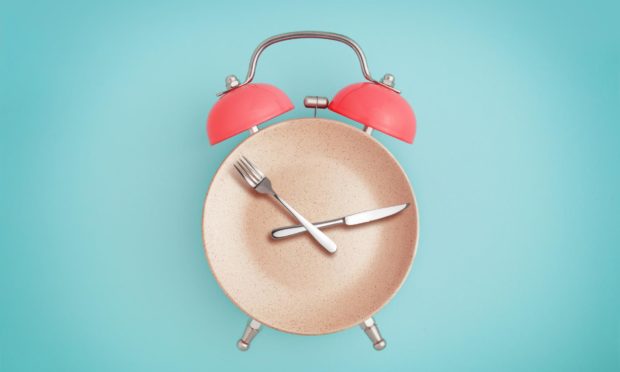Whether it’s the 5:2 or 16:8 plans, fasting diets have won celebrity fans in recent years, but are they a good idea?
In the spirit of new year, new start, January is the most popular month for rethinking what we eat and drink.
And while there are a huge range of diets to choose from, fasting has become an increasingly popular choice over the last decade.
Intermittent fasting typically involves not eating or drinking anything other than water for set periods of time, and in some cases limiting your calorie intake in the hours you are allowed to eat.
Is it safe?
The NHS website took an indepth look at a study into the benefits of fasting on alternate days and suggested that restricting calorie intake in this way may not be a good idea for those who have a chronic health condition or a history of eating disorders. Anyone in these categories is advised to speak to their GP before embarking on a new diet plan.
In general for healthy individuals, following a tried and tested and moderate fasting plan such as the 5:2 or 16:8 diets, is considered safe.
Is it a good way to lose weight?
Research from the University of California, San Francisco, recently poured cold water on the idea that simply restricting your hours of eating was enough to shift the pounds.
They tasked a group of volunteers with following a 16:8 fasting diet, while others ate three meals a day whenever they wanted.
Both groups saw a modest fall in their weight, suggesting the fasting plan made virtually no difference.
The diet is based on the 8 Hour Diet book, by author David Zinczenko and editor-in-chief of Men’s Health Peter Moore, who argues that a daily fasting period gives the body the time it needs to process food and burn away extra fat.
Scottish dietitian Dr Carrie Ruxton, who herself follows a 16:8 type plan, believes limiting your hours of eating can be useful but only if you are cutting out calories within that timeframe.
She said: “My take on this study is it’s good news that you can lose weight either way. For a long time I’ve believed there are many ways to lose weight and it depends on your own personal circumstances, preferences and the way you want to live your life.
“Too many people have been given the lie that there’s a perfect diet that you have to follow if you want to lose weight or be healthy and you’re made to feel guilty.
“If you eat carbohydrates you’re told, ‘Oh no, you shouldn’t be having that,’ or it’s the same if you eat fat, so it’s almost like for everything you want to eat there’s somebody leaning over your shoulder telling you you can’t eat it.
“It comes down to calories at the end of the day so whichever method works for you to cut your calories and create a calorie deficit, that is how you will lose weight best.”
How Carrie uses the 16:8
“I’m careful with my weight because I have quite a sedentary job. Even though I exercise I spend most of my day in front of my computer. So I tend to do the 16:8. This morning I got up and made my breakfast, put it in the fridge and ate it around noon.
“I go and do something active in the morning and then I have a late breakfast and at eight at night I stop eating and that’s it for the rest of the day. That works for me.
“I don’t have a lot of weight to come off, it’s just sometimes I’ll stand on the scales and think, ‘Oh dear, that’s another couple of pounds I need to lose,’ so I do the 16:8 for a week or so and it gets back under control again.
“It’s something I do on and off. There have been studies showing that people who will manage to stay in a healthy weight range for all of their adult life, are people who are just now and again doing a little check and keeping an eye on it so that they aren’t going too far out of their range. Those who deny it and let the problem build up will find it harder.”
Small and steady wins the day
Carrie believes the best way to keep your weight under control is to do frequent, but not daily, checks so that you can act quickly if you happen to have gained a couple of pounds.
She said: “The better way of doing it is every week or two just have a little check, it could be by trying on the same pair of jeans or trousers, or it could be standing on the scales, and if you see your weight creeping up tackle it quickly by limiting calories.
“You could eat less at mealtimes with a smaller plate of food, or follow 5:2 – it doesn’t work for me because I can’t eat a small amount for a whole day, but some people like that – or you could try 16:8, or go to a slimmers’ club for moral support, or see if your gym does a healthy eating plan. Even the liquid diets are worth considering.
“There is evidence showing this is very helpful for reversing diabetes, so there are lots of options and it’s about finding what’s right for you.”
5:2 versus 16:8
5:2
In 2012, the BBC broadcast a Horizon episode called ‘Eat, Fast and Live Longer’, presented by Dr Michael Mosley in which the idea of intermittent fasting was first introduced on a major platform.
He then published The Fast Diet book in January 2013, which was closely followed by a similar book from former BBC journalist, Kate Harrison called The 5:2 Diet Book. Their similar plans proved to be the order of the day, with both books becoming bestsellers.
Under the 5:2 diet, you eat broadly what you like five days a week within the recommended calorie range. Dieters are then recommended to eat just a quarter of their usual calorie intake – so going down to 500 calories for women and 600 for men – for two consecutive days.
16:8
This diet is potentially a little easier to follow, but it is a seven-day-a-week plan which sees you only eat solids eight hours out of 24.
Generally, followers of the plan will eat between midday and 8pm and, outside of those eight hours, will stick to unsweetened liquids such as water, tea and coffee.


